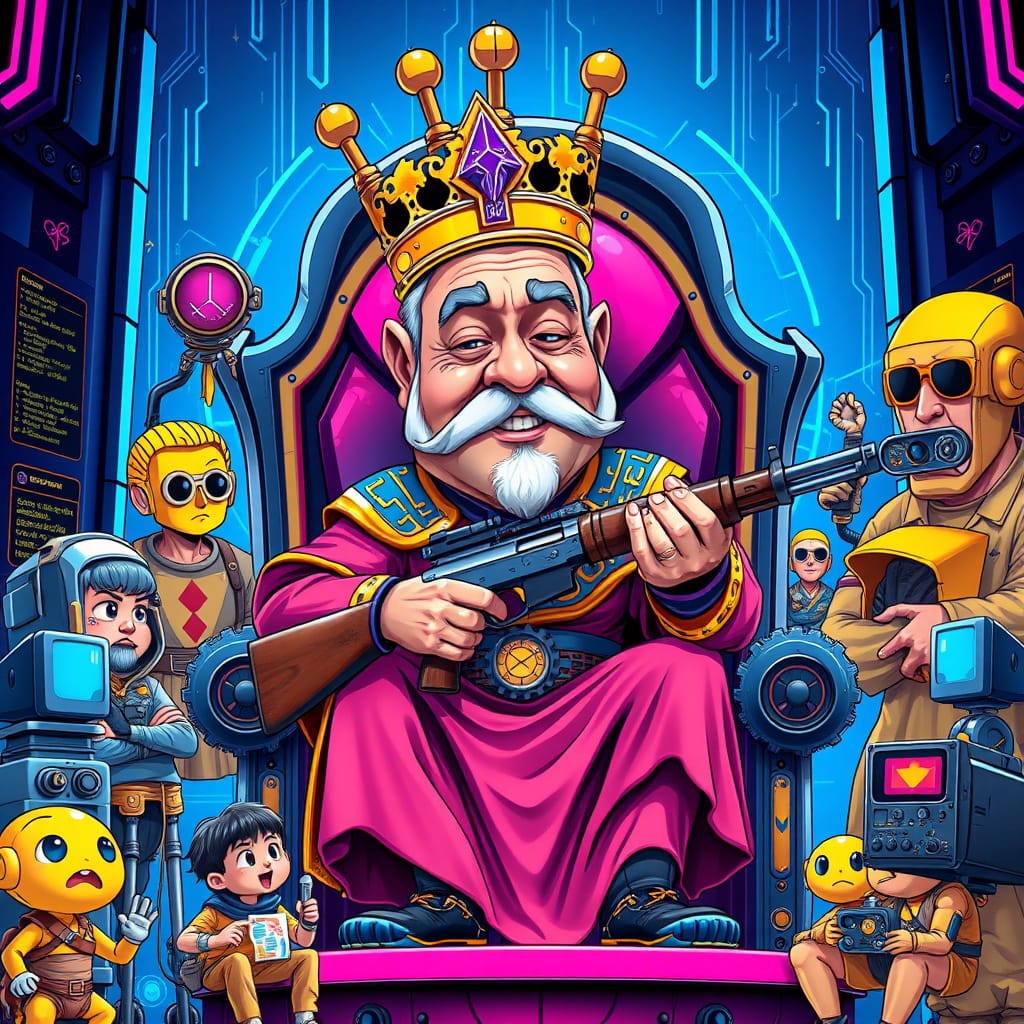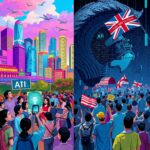In the gleaming conference rooms of Silicon Valley, where venture capitalists gather like digital evangelists clutching their kombucha and quarterly projections, a curious form of doublethink has taken hold. Artificial Intelligence, they proclaim with the fervor of true believers, is simultaneously the solution to every human problem and a technology so nascent that any criticism of its current limitations constitutes heresy against the future itself.
The Ministry of Technological Truth has spoken: AI will cure cancer, eliminate poverty, solve climate change, and presumably teach your grandmother to use TikTok. Yet somehow, after billions in investment and years of breathless proclamations, the most advanced AI systems still struggle with tasks that a moderately caffeinated human intern could handle—like accurately counting the number of fingers in a photograph or explaining why they recommended a documentary about serial killers after you watched one cooking show.
This is not mere technological growing pains. This is the systematic construction of a narrative so divorced from reality that it would make the Ministry of Plenty proud. The tech industry has perfected the art of selling tomorrow’s promises with today’s marketing budgets, creating a perpetual state of “almost there” that justifies infinite investment in solutions to problems that may not actually exist.
The Algorithmic Cargo Cult
The current AI revolution bears striking resemblance to a cargo cult, where primitive societies built mock airstrips hoping to summon the return of supply planes. Silicon Valley has constructed elaborate mock-ups of intelligence—systems that can mimic human responses with uncanny accuracy while possessing roughly the same understanding of the world as a particularly sophisticated parrot.
Dr. Miranda Blackwell, former head of AI ethics at Prometheus Technologies (before the position was “restructured for optimal synergy alignment”), observed this phenomenon firsthand. “We had executives who genuinely believed that adding ‘AI-powered’ to any product description would increase its valuation by 300%,” she noted during a recent interview. “I watched a team spend six months building an ‘AI-driven’ email sorting system that was essentially a series of if-then statements a computer science student could have written in an afternoon.”
The cargo cult mentality extends beyond mere marketing hyperbole. Entire industries have reorganized themselves around the assumption that AI will soon achieve capabilities that remain stubbornly theoretical. Companies hire Chief AI Officers who spend their days attending conferences about the transformative potential of technologies that don’t quite work yet. It’s as if the entire tech ecosystem has agreed to collectively pretend that the emperor’s new clothes are not only visible but revolutionary.
The Great Automation Mirage
Perhaps nowhere is the gap between AI promise and AI reality more pronounced than in the realm of automation. For years, tech luminaries have warned of an impending AI-pocalypse, where artificial intelligence would render human labor obsolete faster than you could say “universal basic income.” Yet walk into any office, factory, or service establishment, and you’ll find humans doing essentially the same jobs they’ve always done, albeit now with the added responsibility of training AI systems that occasionally work as advertised.
The automation revolution has proceeded with all the urgency of a government bureaucracy implementing new filing procedures. Self-driving cars, promised to be ubiquitous by 2020, remain confined to carefully mapped routes in optimal weather conditions, supervised by human safety drivers who must be ready to take control at any moment. Amazon’s automated warehouses still employ hundreds of thousands of human workers, who have simply been promoted from “warehouse workers” to “automation supervisors”—a title change that comes with the same pay but twice the stress.
“We’ve essentially created the most expensive way possible to do things we were already doing,” explained former Tesla engineer Marcus Chen, who left the company after what he describes as “one too many meetings about revolutionary breakthroughs that were actually incremental improvements to existing systems.” The irony, Chen notes, is that the human workers displaced by automation are often rehired to maintain, monitor, and fix the systems that replaced them.
The Productivity Paradox Strikes Again
The tech industry’s relationship with productivity reveals the fundamental contradiction at the heart of the AI revolution. Despite decades of technological advancement and billions invested in artificial intelligence, productivity growth in most sectors has remained stubbornly flat. This is not a new phenomenon—economists have been puzzling over the “productivity paradox” since the advent of personal computers—but AI was supposed to be different. It was supposed to be the technology that finally delivered on the promise of exponential efficiency gains.
Instead, we’ve created what researchers at the Institute for Digital Skepticism call “productivity theater”—elaborate systems that create the appearance of efficiency while often making simple tasks more complex. Consider the modern customer service experience, where AI chatbots force customers through increasingly Byzantine decision trees before inevitably connecting them to human agents who must then decipher what the AI was trying to accomplish.
The paradox extends to knowledge work, where AI-powered tools promise to augment human capabilities but often require more time to manage than they save. Lawyers spend hours reviewing AI-generated legal briefs for hallucinations and errors. Doctors must double-check AI diagnostic suggestions that occasionally confuse skin conditions with furniture patterns. Writers use AI to generate first drafts that require so much editing they might as well have started from scratch—but with the added anxiety of wondering whether their AI assistant has inadvertently plagiarized someone else’s work.
The Hallucination Economy
Perhaps the most telling aspect of current AI limitations is the industry’s embrace of “hallucination” as a technical term for when AI systems confidently present false information as fact. In any other field, a system that regularly fabricated data would be considered fundamentally broken. In AI, hallucination is treated as a charming quirk that will surely be resolved in the next iteration.
This linguistic sleight of hand reveals the deeper problem with AI evangelism: the systematic redefinition of failure as progress. When an AI system provides incorrect medical advice, it’s not a dangerous malfunction—it’s a “learning opportunity.” When autonomous vehicles cause accidents, they’re not defective products—they’re “gathering valuable real-world data.” When AI hiring systems exhibit obvious bias, they’re not discriminatory tools—they’re “reflecting societal patterns that require further algorithmic refinement.”
The hallucination economy has created a new class of digital fact-checkers whose full-time job is verifying the output of systems that were supposed to eliminate the need for human verification. Universities now employ armies of teaching assistants to grade papers written by students using AI, which are then evaluated by AI plagiarism detection systems that must be manually reviewed by humans who try to determine whether the AI detector correctly identified AI-generated content.
The Venture Capital Reality Distortion Field
The persistence of AI hype despite its obvious limitations can be traced directly to the venture capital ecosystem that funds Silicon Valley’s reality distortion field. VCs have invested so heavily in the AI narrative that acknowledging its current limitations would require admitting that billions of dollars have been allocated based on science fiction rather than science.
This creates a feedback loop where startups must claim revolutionary AI capabilities to secure funding, then spend their runway trying to build technology that matches their marketing claims. The result is an industry populated by companies that are simultaneously cutting-edge AI pioneers and elaborate Potemkin villages, depending on whether you’re talking to their marketing department or their engineering team.
“The entire ecosystem is built on the assumption that AI will eventually work as advertised,” explained venture capitalist turned whistleblower Sarah Rodriguez. “But ‘eventually’ has become a magic word that justifies any amount of present-day dysfunction. It’s like investing in a restaurant chain that doesn’t serve food yet but promises to revolutionize dining once they figure out cooking.”
The Human Resistance
Despite years of conditioning, humans have proven remarkably resistant to AI replacement in ways that consistently surprise technologists. It turns out that much of what we value about human interaction—empathy, creativity, contextual understanding, the ability to navigate ambiguity—are precisely the qualities that current AI systems struggle to replicate convincingly.
Customer service representatives report that clients often specifically request to speak with humans, even when AI systems are technically capable of handling their requests. Teachers find that students prefer feedback from human instructors, even when AI can provide more detailed analysis. Patients consistently rate interactions with human doctors more highly than AI-assisted consultations, regardless of diagnostic accuracy.
This preference for human interaction isn’t mere technophobia—it reflects a deeper understanding that intelligence involves more than pattern matching and statistical prediction. Humans excel at reading between the lines, understanding unspoken context, and providing the kind of nuanced judgment that comes from lived experience rather than training data.
The Coming Reckoning
As the AI hype cycle reaches peak absurdity, signs of a reckoning are beginning to emerge. Companies that built their valuations on AI promises are quietly scaling back their claims. Investors are starting to ask uncomfortable questions about return on investment. Employees are pushing back against AI systems that make their jobs more difficult rather than easier.
The tech industry’s response has been predictably Orwellian: redefining success to match reality rather than adjusting reality to match promises. AI systems that fail to achieve human-level performance are now described as “narrow AI” that was never intended to be general-purpose. Automation projects that require constant human supervision are rebranded as “human-AI collaboration.” Products that don’t work as advertised are positioned as “early adopter experiences” that will improve with user feedback.
What’s your experience with AI systems that promise the world but deliver something closer to a moderately intelligent autocomplete? Have you encountered the productivity paradox in your own work, where AI tools create more problems than they solve? Share your stories of AI disappointment below—misery loves company, and apparently so does artificial intelligence.
Enjoyed this dose of uncomfortable truth? This article is just one layer of the onion.
My new book, “The Subtle Art of Not Giving a Prompt,” is the definitive survival manual for the AI age. It’s a guide to thriving in a world of intelligent machines by first admitting everything you fear is wrong (and probably your fault).
If you want to stop panicking about AI and start using it as a tool for your own liberation, this is the book you need.
>> Get your copy now (eBook & Paperback available) <<





GIPHY App Key not set. Please check settings